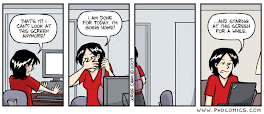Appearance of hypermetropic eye

The farsighted eye, unlike the myopic eye, is smaller than usual, or its lenses have less power.
Consequently, the image is focused BEHIND the retina.

Development
Some authors “…concluded that the growth of the eye during infancy is extremely rapid, and its adult size is reached by the age of 3 years…” and that “…the process of emmetropization is evident during the first year of life…”.
“…by the ages of 6 to 8 years old emmetropization has taken place, the great majority of the children being in the emmetropic group, which has its peaks at 1.00 diopter of hyperopia…”
There is a high percentage of children who were born hyperopic, because our eyes, when we were born, are not completely developed, and are small. As time goes by, if this hypermetropia is low, it disappears when the eye grows, so that sometimes, it can even turn it into myopia in school years.
Hyperopia, unlike myopia, do not usually vary until getting into adult years. At that moment, the appearance of presbyopia or “old sight” causes that the hyperopia increases much more, either hyperopia can appear or the myopia can even decrease.
Prevalence
Around 10% of people in Spain suffer from hypermetropia. 22.4% of population in USA and Australia is hyperopic. Specifically, there is a prevalence of 12.8% in American children aged 5-17 years.
In school years, hyperopia is usually lesser worrying than myopia because the clinically significant values of hypermetropia (and astigmatism) are 2-4% of the children who begin the school years, and also, these values do not increase over time.
“Hypermetropia is influenced by ethnicity. Native Americans, African Americans, and Pacific Islanders are among the groups with the highest reported prevalence of hyperopia. A study of 1.880 Chinese schoolchildren in Malaysia showed that the prevalence of hyperopia greater than +1.25 diopter, was only 1.2%”. (pag 8)
Probability

Factors
If you remember, environmental factors are very important in myopia; however, although the majority of children are hypermetropic when they start the school years, the hyperopia does not usually increase, but it decreases if anything.
Therefore, its existence is usually thought to be caused by hereditary factors.
In the other hand, a visual disorder derived from hyperopia is the presbyopia or “old sight”, that is typical of old people. In this case, this disorder is product of the time as it goes by. The ciliary muscle, as the rest of body muscles, loses elasticity and strength, and as well the capacity of being contracted; this way, the lens can not be more convex, and that prevents the accommodation to happen. That is why hyperopic people begin to suffer presbyopia earlier than emmetropic people; and these ones, earlier than myopic people.
RELATED POST
Refractive disorders: Hyperopia , Hypermetropia or Farsightedness. (1) Vision and Accommodation
Refractive disorders: Hyperopia. (3) Symptoms.
Refractive disorders: Hyperopia. (4) Solutions.
Refractive visual disorders. Some clarifications.
Some numbers...








